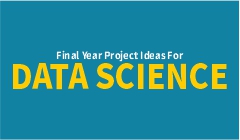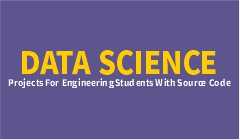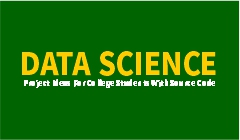
Introduction
Selecting the appropriate final year project in data science can prove to be a career-defining milestone for a student. For most engineering students, data science projects do not merely mean a means to complete their academic course but also serve as a platform to create a solid portfolio reflecting hard skills in the real world. As there is growing need for data scientists across India and other countries, final year students are getting more interested in projects where machine learning, artificial intelligence, big data, and Python programming converge.
Here, we'll discuss data science final year project ideas that can make the students distinguished. These projects include data analysis, predictive modeling, NLP, computer vision, recommendation systems, etc. We'll also emphasize the need for hands-on projects with source code to increase confidence and improve employability.
If you are looking for final year data science project topics that capture industry trends, academic needs, and practical problem-solving, this guide will assist you in selecting the right one.
Why Are Final Year Data Science Projects Important?
Before we go into the project ideas, it is important to know why data science projects for final year students matter:
Core Technologies for Data Science Final Year Projects
Prior to selecting a project, students must keep themselves informed regarding the tools and technologies utilized in data science final year projects:
Knowledge of these tools helps ensure that students can effectively implement projects as well as present them during interviews or placements.
Best Final Year Project Ideas for Data Science
Below is a grouped set of data science final year project ideas, together with implementation tips and potential extensions.
1. Machine Learning-Based Final Year Projects
Loan Default Prediction System
Stock Price Prediction
Credit Card Fraud Detection
2. Final Year Data Analytics Projects
Final year data analytics projects are ideal for engineering students wishing to specialize in data interpretation, insights, and visualization.
Sales Data Analysis for Retail Businesses
COVID-19 Data Visualization Dashboard
E-commerce Customer Buying Behavior Analysis
3. Artificial Intelligence and Deep Learning Projects
Deep learning is an emerging area and is much sought after in the industry. Students can do projects on neural networks and AI applications.
Facial Emotion Recognition System
Handwritten Digit Recognition
AI Chatbot for College Support
4. Natural Language Processing (NLP) Projects
Sentiment Analysis on Social Media Data
Fake News Detection System
Resume Screening Automation
5. Computer Vision Projects
Computer vision projects are favored by students of engineering who wish to use image and video processing methodologies.
Traffic Sign Recognition System
Medical Image Classification
Object Detection in Smart Surveillance
6. Big Data Projects for Final Year
Big data projects are ideal for students who wish to work on large datasets and distributed systems.
Real-Time Data Pipeline for IoT Devices
Weather Forecasting Using Big Data Analytics
Social Media Analytics with Hadoop
7. Recommendation System Projects
Movie Recommendation System
Online Learning Platform Recommendation
Product Recommendation for E-commerce
Tips to Make Your Final Year Data Science Project Stand Out
Career Benefits of Doing Data Science Projects in Final Year
Final year data science projects have long-term career benefits:
Conclusion
Data science final year projects are not just academic tasks—they are employment opportunities. Whether you pursue machine learning, deep learning, NLP, big data, or recommendation systems, ensure your project showcases practical skills, innovation, and problem-solving skill. By completing these final year data science project ideas, engineering students can design meaningful solutions and enhance their employability in one of the most sought-after career areas.
If you are an engineering student seeking data science projects with source code, this tutorial has provided you with a broad list of cutting-edge project topics to consider. Pick the best one according to your interest, apply it using Python and appropriate libraries, and present it confidently.

Introduction
With the advent of the digital age, data science has also emerged as one of the most sought-after career options, and engineering students who wish to become data scientists, machine learning engineers, or AI experts can enhance their job prospects by engaging in real-world projects. Mere acquisition of theories is not sufficient—practical projects involving source code expose engineering students to hands-on experience with data preprocessing, machine learning algorithms, and model deployment.
If you are a student of engineering in pursuit of the top data science project ideas with source code, this tutorial is for you. In this tutorial, we will discuss beginner-friendly to advanced project ideas, outline their significance, and provide project categories that not only make your resume stand out but also prepare you for data-driven career opportunities.
Why Engineering Students Should Work on Data Science Projects?
Before diving into project ideas, it’s important to understand why data science projects are essential:
Important Technologies for Data Science Projects
Engineering students need to have hands-on experience with the following tools and libraries when working on projects:
Best Data Science Project Types for Engineering Students
To assist you in deciding on an appropriate project idea, below are some categories with ideas and source code recommendations:
1. Data Science Projects for Beginners
Techniques: Linear Regression, Random Forest
Skills: Data cleaning, feature engineering
Weather Forecasting Model
Skills: Time-series forecasting
Movie Recommendation System
Algorithms: Collaborative Filtering, Content-based Filtering
2. Intermediate-Level Data Science Projects
Customer Churn Prediction
Algorithms: Logistic Regression, XGBoost
Real-world Application: Telecom & banking industries
Fake News Detection
Tools: Natural Language Processing (NLP), TF-IDF, LSTM
Useful for: Journalism, social media monitoring
Sentiment Analysis of Tweets
Libraries: NLTK, SpaCy, Transformers
3. Advanced Data Science Projects
Credit Card Fraud Detection
Skills: Anomaly Detection, Classification Models
Autonomous Vehicle Data Analysis
Tools: TensorFlow, OpenCV, CNN
Healthcare Predictive Analytics
Skills: Classification, Neural Networks
Data Science Projects with Source Code (Python Examples)
Here are some ideas of sample source code (simplified) for engineering students:
Example 1: Student Performance Prediction
import pandas as pd
from sklearn.model_selection import train_test_split
from sklearn.linear_model import LinearRegression
# Load dataset
data = pd.read_csv("student_scores.csv")
# Features and target
X = data[['Hours_Studied', 'Attendance']]
y = data['Score']
# Split dataset
X_train, X_test, y_train, y_test = train_test_split(X, y, test_size=0.2)
# Train model
model = LinearRegression()
model.fit(X_train, y_train)
# Predict
predictions = model.predict(X_test)
print(predictions)
Example 2: Fake News Detection
import pandas as pd
from sklearn.feature_extraction.text import TfidfVectorizer
from sklearn.model_selection import train_test_split
from sklearn.linear_model import PassiveAggressiveClassifier
# Load dataset
data = pd.read_csv("news.csv")
X = data['text']
y = data['label']
# Convert text to features
vectorizer = TfidfVectorizer(stop_words='english', max_df=0.7)
X = vectorizer.fit_transform(X)
# Train-test split
X_train, X_test, y_train, y_test = train_test_split(X, y, test_size=0.2)
# Train model
model = PassiveAggressiveClassifier(max_iter=50)
model.fit(X_train, y_train)
# Accuracy
print("Model Accuracy:", model.score(X_test, y_test))
Example 3: Credit Card Fraud Detection
import pandas as pd
from sklearn.ensemble import RandomForestClassifier
from sklearn.model_selection import train_test_split
# Load dataset
data = pd.read_csv("creditcard.csv")
X = data.drop('Class', axis=1)
y = data['Class']
# Train-test split
X_train, X_test, y_train, y_test = train_test_split(X, y, test_size=0.2)
# Train model
model = RandomForestClassifier()
model.fit(X_train, y_train)
# Evaluate
print("Model Accuracy:", model.score(X_test, y_test))
How Engineering Students Can Choose the Right Data Science Project
Advantages of Conducting Data Science Projects with Source Code
Future Scope for Engineering Students in Data Science
As industries are embracing AI, machine learning, and big data analytics, the career prospect of data science for engineering students is quite high. By incorporating value-added projects to your resume, you can get placed as:
Conclusion
Projects in data science with source code is perhaps the most efficient method for engineering students to achieve hands-on experience, bolster their technical portfolio, and set themselves up for a successful career in the data-driven economy. Whether they are undertaking basic regression-based projects or sophisticated deep learning projects, opportunities are limitless.
If you are an engineering student, begin playing with Python-based data science projects today itself. Keep in mind: the more projects you construct, the better will your prospects for becoming an industry-ready data scientist.

Introduction
Data science is one of the most sought-after professions in the 21st century that uses programming, mathematics, statistics, and domain expertise to extract insights from data. For students at the university level, studying data science is not only about theory but also application. Creating data science projects with source code assists students in grasping real-world issues, implementing machine learning algorithms, and building their portfolio for internships and employment.
If you are a student looking for data science project ideas for college students with source code, this guide includes an extensive list of beginner to expert projects. The projects are with trending technologies, industry demands, and academic requirements.
Why Data Science Projects Are Important for College Students?
Let's find out why data science projects are significant before moving to the ideas:
Key Skills Needed for Data Science Projects
To implement these projects effectively, students must enhance the following skills:
Best Data Science Project Ideas for College Students with Source Code
Here are project ideas for students at various levels categorized:
1. Beginner Level Data Science Project Ideas
These projects are ideal for students beginning with Python and data science fundamentals.
Student Performance Prediction
Iris Flower Classification
Movie Recommendation System
Stock Price Prediction
Fake News Detection
2. Intermediate-Level Data Science Project Ideas
For students with prior experience in Python, machine learning, and data visualization.
Sentiment Analysis of Social Media Data
Credit Card Fraud Detection
Customer Segmentation Using Clustering
Handwritten Digit Recognition (MNIST Dataset)
Resume Screening Tool
3. Advanced Level Data Science Project Ideas
These are deep learning, big data, and real-time data applications. Best for final-year projects.
Autonomous Driving System Simulation
Chatbot with Machine Learning
Medical Image Classification
Real-Time Traffic Prediction System
Speech Recognition System
How to Select the Optimal Data Science Project?
While choosing your final-year data science project with source code, follow these reminders:
Step-by-Step Guide to Building a Data Science Project
Here's how students can tackle projects effectively:
1. Define the Problem Statement
2. Collect and Prepare Data
3. Exploratory Data Analysis (EDA)
4. Use Machine Learning Algorithms
5. Model Evaluation
6. Deployment (Optional)
7. Documentation and Source Code
Data Science Project Ideas by Domains
Healthcare Projects
Finance Projects
Education Projects
Retail & E-commerce Projects
Tips to Showcase Data Science Projects in College
Conclusion
Data science provides a tremendous scope for college students. Developing data science project ideas with source code not only enhances technical proficiency but also aids in creating a professional portfolio that gets noticed in the job market. Ranging from simple projects such as flower classification to complex applications such as medical image analysis and chatbots, students have infinite opportunities.
By selecting the appropriate project, using machine learning algorithms, and documenting your work correctly, you can make your final-year project practical and job-oriented. Keep in mind that practice, experimentation, and problem-solving using real-world data is the key to becoming a good data scientist.
So, select a project, begin coding in Python, and initiate your journey to becoming an industry-ready data scientist!